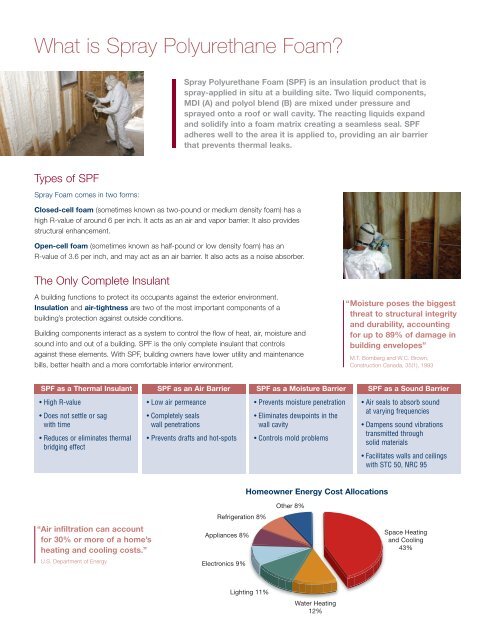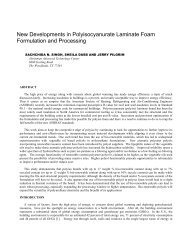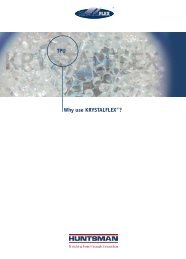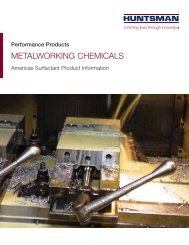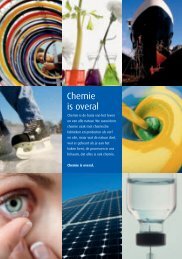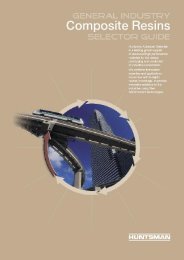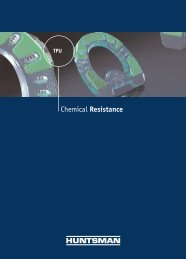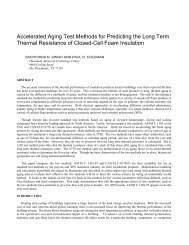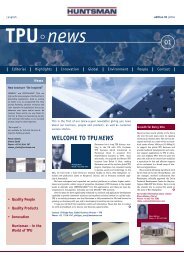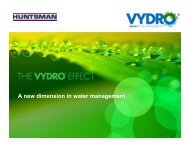Spray Polyurethane Foam Insulation
Spray Polyurethane Foam Insulation
Spray Polyurethane Foam Insulation
Create successful ePaper yourself
Turn your PDF publications into a flip-book with our unique Google optimized e-Paper software.
What is <strong>Spray</strong> <strong>Polyurethane</strong> <strong>Foam</strong>?<br />
Types of SPF<br />
<strong>Spray</strong> <strong>Foam</strong> comes in two forms:<br />
Closed-cell foam (sometimes known as two-pound or medium density foam) has a<br />
high R-value of around 6 per inch. It acts as an air and vapor barrier. It also provides<br />
structural enhancement.<br />
Open-cell foam (sometimes known as half-pound or low density foam) has an<br />
R-value of 3.6 per inch, and may act as an air barrier. It also acts as a noise absorber.<br />
The Only Complete Insulant<br />
A building functions to protect its occupants against the exterior environment.<br />
<strong>Insulation</strong> and air-tightness are two of the most important components of a<br />
building’s protection against outside conditions.<br />
Building components interact as a system to control the flow of heat, air, moisture and<br />
sound into and out of a building. SPF is the only complete insulant that controls<br />
against these elements. With SPF, building owners have lower utility and maintenance<br />
bills, better health and a more comfortable interior environment.<br />
SPF as a Thermal Insulant<br />
• High R-value<br />
• Does not settle or sag<br />
with time<br />
• Reduces or eliminates thermal<br />
bridging effect<br />
“Air infiltration can account<br />
for 30% or more of a home’s<br />
heating and cooling costs.”<br />
U.S. Department of Energy<br />
<strong>Spray</strong> <strong>Polyurethane</strong> <strong>Foam</strong> (SPF) is an insulation product that is<br />
spray-applied in situ at a building site. Two liquid components,<br />
MDI (A) and polyol blend (B) are mixed under pressure and<br />
sprayed onto a roof or wall cavity. The reacting liquids expand<br />
and solidify into a foam matrix creating a seamless seal. SPF<br />
adheres well to the area it is applied to, providing an air barrier<br />
that prevents thermal leaks.<br />
SPF as an Air Barrier<br />
• Low air permeance<br />
• Completely seals<br />
wall penetrations<br />
• Prevents drafts and hot-spots<br />
Refrigeration 8%<br />
Appliances 8%<br />
Electronics 9%<br />
SPF as a Moisture Barrier<br />
• Prevents moisture penetration<br />
• Eliminates dewpoints in the<br />
wall cavity<br />
• Controls mold problems<br />
Homeowner Energy Cost Allocations<br />
Lighting 11%<br />
Other 8%<br />
Water Heating<br />
12%<br />
“Moisture poses the biggest<br />
threat to structural integrity<br />
and durability, accounting<br />
for up to 89% of damage in<br />
building envelopes”<br />
M.T. Bomberg and W.C. Brown,<br />
Construction Canada, 35(1), 1993<br />
SPF as a Sound Barrier<br />
• Air seals to absorb sound<br />
at varying frequencies<br />
• Dampens sound vibrations<br />
transmitted through<br />
solid materials<br />
• Facilitates walls and ceilings<br />
with STC 50, NRC 95<br />
Space Heating<br />
and Cooling<br />
43%


